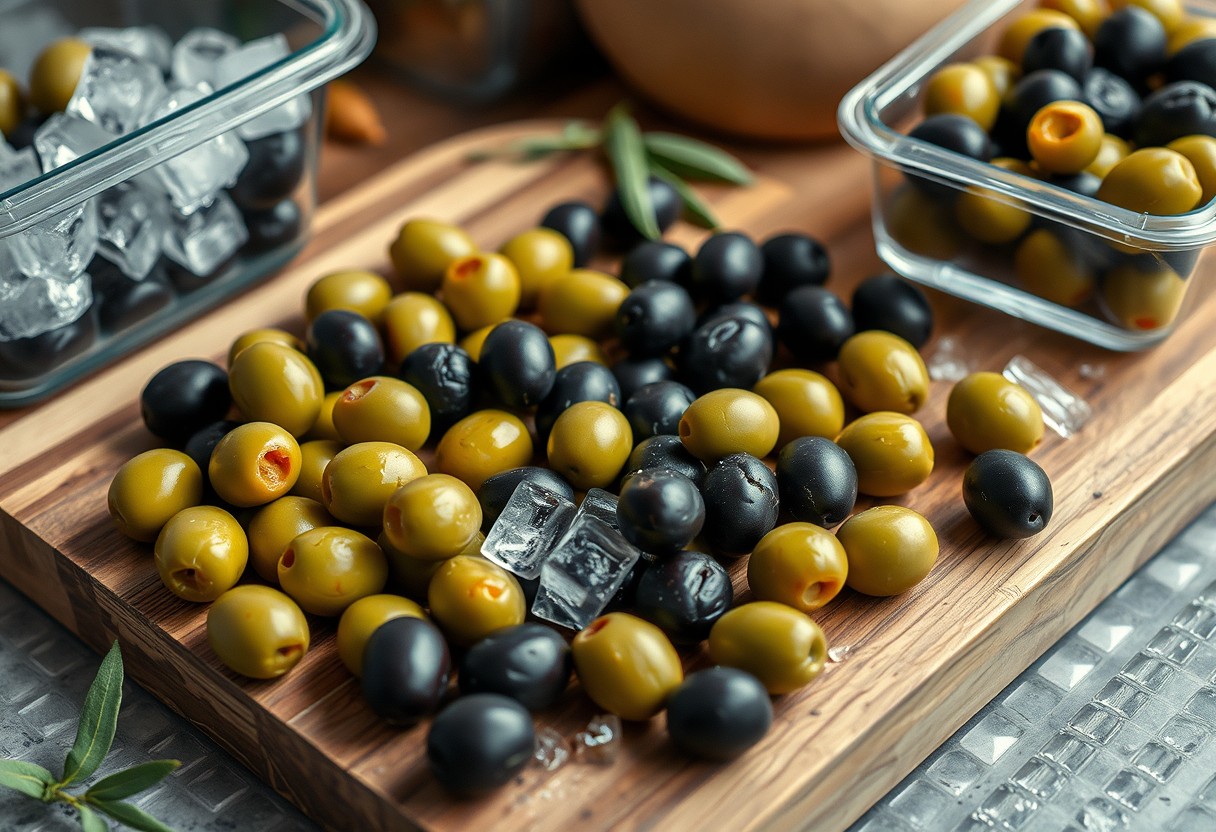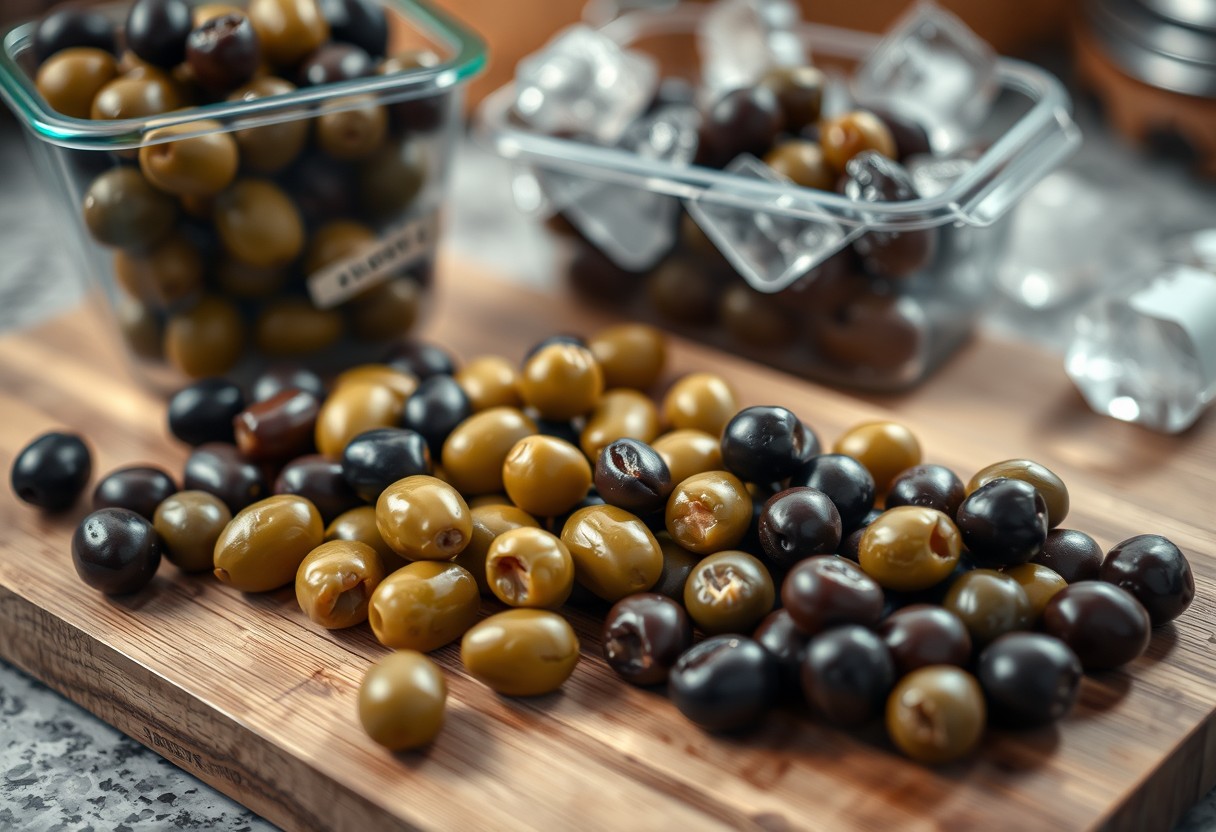Olives are a versatile ingredient in many dishes, but you may wonder if you can freeze them for future use. Understanding how freezing affects their texture and flavor is crucial to preserving their quality. In this post, you’ll learn about the best methods for freezing olives, how to store them properly, and whether it’s a suitable option for your culinary needs. By the end, you’ll be equipped with the knowledge to make the best choice for your olive storage concerns.

Key Takeaways:
- Olive Freezing: You can freeze olives, but it may change their texture and flavor.
- Preparation: Rinse and drain the olives before freezing, and consider using airtight containers to prevent freezer burn.
- Usage: Frozen olives are best used in cooked dishes, as the freezing process can affect their crunchiness.

Understanding Olives
While many people enjoy olives for their unique flavor and versatility, understanding them can enhance your culinary experience. Olives are small fruits of the Olea europaea tree, native to the Mediterranean region. They come in various colors and sizes, with each type exhibiting distinct taste profiles. Your appreciation of olives will deepen as you explore their history, types, and nutritional benefits.
Types of Olives
While olives may appear similar, they actually come in numerous varieties, each with its own unique flavor and texture. Here’s a quick guide to some popular types:
| Type | Description |
| Kalamata | Dark purple, almond-shaped, with a fruity flavor. |
| Manzanilla | Small, green, and firm, often brined for pickled taste. |
| Castelvetrano | Bright green, sweet, and crunchy, loved for its mild flavor. |
| Gaeta | Small, wrinkled, black olives with a rich, tangy taste. |
| Niçoise | Black, small, and soft; commonly used in French cuisine. |
After you discover these varieties, you’ll find each type suits different dishes and preferences.
Nutritional Benefits of Olives
Olives are not just tasty; they also come packed with numerous health benefits. You can incorporate them into your diet to enjoy their beneficial properties, including healthy fats, antioxidants, and vitamins.
A key aspect of olives is their high content of monounsaturated fats, particularly oleic acid, which may help reduce inflammation and lower cholesterol levels. They also contain antioxidants like vitamin E and polyphenols that combat oxidative stress. By adding olives to your meals, you’ll boost your nutrition while enjoying a delicious flavor that complements many dishes.
Freezing Olives
One great way to preserve the flavor and texture of olives is by freezing them. Freezing allows you to extend their shelf life, making it possible to enjoy olives even when they are out of season. However, not all olives freeze equally well, so it’s necessary to follow the right methods to maintain their quality. Be sure to consider the type of olives you have and prepare them appropriately to ensure the best results when you’re ready to enjoy them later.
The Freezing Process
Process your olives by first rinsing them to remove excess brine or preservatives. Next, you can blanch them for a few minutes to help maintain their color and texture, although this step is optional. After blanching, allow the olives to cool completely before packing them into airtight containers or freezer bags. Remember to label your packages with the date to keep track of how long they have been stored in the freezer.
Best Practices for Freezing
One key to successfully freezing olives is choosing the right variety and preparation method. For optimal results, it’s advisable to use whole olives rather than pitted or sliced ones, as this helps retain their natural moisture and flavor. Additionally, consider flash freezing your olives: spread them in a single layer on a baking sheet and freeze for a few hours before transferring them to airtight containers. This method prevents them from clumping together, making it easier for you to use just the right amount in your dishes.
With these best practices in mind, you can ensure the olives you freeze will taste fresh when you use them later. Be sure to experiment with different varieties and flavors, as this can influence the outcome. Moreover, make sure your olives are properly dried before freezing to avoid ice crystals forming, which can degrade their quality. Following these guidelines will allow you to keep your olives in peak condition for months to come.
Thawing Frozen Olives
To enjoy your frozen olives, it is important to thaw them properly to maintain their flavor and texture. You can easily thaw frozen olives by either placing them in the refrigerator overnight or using the cold water method for quicker results. If you are in a pinch, simply adding them directly to your dish while it is cooking can also work, as heat will help thaw them on the spot.
Recommended Thawing Methods
One effective way to thaw your frozen olives is by transferring them to the refrigerator a day before you plan to use them. If you’re short on time, submerging the olives in a bowl of cold water for about 30 minutes can also yield good results. Avoid using the microwave, as it may compromise the texture and flavor of the olives.
Usage After Thawing
Methods for using your thawed olives largely depend on your intended dish. You can slice them for salads, incorporate them into pasta, or blend them into spreads. Thawed olives can still be flavorful; however, they may be slightly softer than fresh ones, so consider the texture in your culinary choices.
Thawing your olives may lead to a change in their consistency, but this doesn’t affect their usability. You can add them to cooked dishes, dressings, or even enjoy them as a snack. Keep in mind that while thawed olives are perfect for recipes requiring cooked or mixed ingredients, they may not be ideal for garnishing. Always taste before use to ensure they meet your standards.
Potential Effects on Texture and Flavor
After freezing olives, you may notice changes in both texture and flavor. The freezing process can alter the characteristic crunch of olives, and as they thaw, they may become softer and mushier compared to fresh olives. Additionally, their distinct flavor profiles can be affected, leading to a potentially diminished taste experience. Understanding these effects is crucial if you decide to freeze olives for future use.
Texture Changes
Any time you freeze olives, be aware that you are likely altering their original texture. The ice crystals that form during the freezing process can break down their cell walls, resulting in a softer texture upon thawing. This may not be ideal for every dish, as you might prefer the crunch of fresh olives in salads or as toppings.
Flavor Preservation
The freezing process can also impact the flavor of your olives. As they freeze and thaw, some of the complex flavors may become muted or less pronounced.
Understanding how freezing affects flavor can help you make informed decisions about using frozen olives. While frozen olives retain some of their original taste, you may find that they lack the vibrant, fresh notes that come with non-frozen varieties. To mitigate this, consider using your frozen olives in cooked dishes, where heat can help to restore some depth of flavor. Remember that while freezing may be convenient, it may not always deliver the same satisfying taste experience as fresh olives.
Frequently Asked Questions
Once again, you may have questions about freezing olives, and that’s completely natural. Many people wonder about the best methods, suitable olive varieties, and how to properly store your olives once frozen. This section aims to clarify any uncertainties you may have and provide actionable answers to enhance your freezing experience.
Can All Olive Varieties Be Frozen?
To ensure optimal flavor and texture, it’s important to note that not all olive varieties freeze well. While most green and black olives can withstand freezing, oil-cured or brined varieties may not retain their quality post-thaw. It’s best to check specific varieties to ensure you’re choosing olives that will freeze effectively.
How Long Can You Keep Frozen Olives?
To maintain the best quality in your frozen olives, aiming to use them within six months is advisable. They can remain frozen longer, but the flavor and texture may deteriorate over time. Proper storage in airtight containers will help preserve their integrity until you’re ready to use them.
Understanding how long you can keep frozen olives is vital for peak taste and texture. When stored correctly in an airtight container, they can last up to a year in the freezer. However, for optimal flavor, consuming them within six months is best. Regularly checking your freezer’s temperature and sealing containers tightly will help maintain the quality, ensuring that your frozen olives remain delicious when you finally get around to using them.
Tips for Using Frozen Olives
Unlike fresh olives, frozen olives can be slightly softer when thawed, so it’s crucial to know how to incorporate them into your dishes effectively. Here are some tips to enhance your culinary experience:
- Thaw olives in the refrigerator for a few hours before use.
- Add them directly to your cooking for a burst of flavor.
- Use them in salads, pastas, or stews for added texture.
- Consider marinating them for extra taste after thawing.
This approach will help you enjoy the unique taste of olives even after freezing.
Cooking with Frozen Olives
Using frozen olives in your cooking can add a savory depth to a variety of dishes. Simply toss them into stews, sautés, or even casseroles, allowing their flavor to infuse the meal while they cook. Their softer texture makes them ideal for blending in recipes where they can be thoroughly incorporated.
Incorporating into Recipes
The versatility of frozen olives enables you to experiment in your cooking. You can chop them up for tapenade, mix them into a frittata, or include them in a grain bowl. Their rich flavor complements a wide array of other ingredients.
For instance, you can use thawed olives in a Mediterranean pasta dish by sautéing them with garlic, cherry tomatoes, and spinach, creating a vibrant and tasty meal. You might also add them to a traditional Greek salad or blend them into a rich pesto. The possibilities are endless, allowing you to elevate your dishes effortlessly.
Final Words
Hence, if you’re considering freezing olives, you now understand that it’s a viable option for extending their shelf life, particularly for bulk purchases or leftovers. Just remember to remove the pits, choose your freezing method wisely, and utilize them within a few months for the best taste and texture. By taking these steps, you can enjoy the convenience of having olives on hand for your culinary creations while minimizing waste.





Leave a Reply